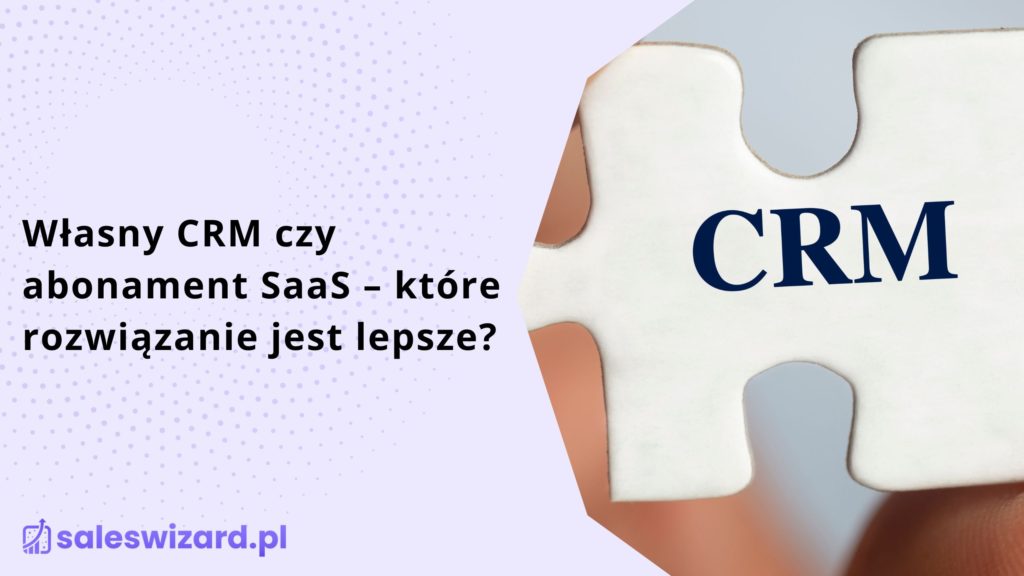Custom CRM or SaaS subscription – which solution is better?

Modern CRM systems are most often based on a SaaS solution, or System as a Service – software as a service. Once the subscription is paid, the entrepreneur gains access to the CRM tool without having to install software or do any IT work themselves. There is also an alternative to SaaS subscriptions in the form of building your own CRM. The concept of an in-house CRM system implies significant ongoing and future work in exchange for independence from external service providers. Which of these solutions is better and why?
SaaS, or all-inclusive system rental
If I wanted to describe CRM in the simplest way in the SaaS model, I would compare this solution to a long-term car rental. In fact, I will not become its owner, but a user, which paradoxically brings many advantages. I don’t have to worry about insurance, paying for maintenance service or vulcanization services. My only expense is to refuel, add windshield washer fluid and pay the rental fee. Similarly, in the SaaS model – I only pay for the use of the system, which is treated as a service. I’m not interested in buying and maintaining servers, funding IT specialists or creating functionality to streamline my work. All these aspects are on the side of the CRM distributor, and it is in his interest to provide the best possible service. Otherwise, I will not hesitate to terminate the contract and choose a CRM that meets my expectations one hundred percent.
Strengths and weaknesses of the SaaS model
There is no doubt that the biggest advantage of a SaaS system is its flexibility in the broadest sense. It concerns not only the freedom to conclude and terminate a contract, but also the ability to shape one’s access package. More demanding customers or those who do increased work on the CRM may opt for more expensive packages, while companies that use the tool sporadically will settle for the cheapest subscriptions. You can increase or decrease the package level at any time, which will affect the price. The strength is also in the do-nothing aspect – the CRM user has absolutely no interest in the technical maintenance of the system. All repair work and improvements are the responsibility of the supplier, which has a well-trained IT team. On the downside of the SaaS model, I can point to the fact that we do not and will not really own the CRM program outright. If I stop paying invoices, I will lose access to the CRM database with contacts, and thus I am partially dependent on the providers of the CRM tool.
Own CRM – independence and no external fees
On the other side, in a kind of opposition to the SaaS system is the mechanism for building a CRM system on its own. It will be about creating a custom CRM from scratch, which will be closely tailored to the needs of the enterprise. Using the analogy of a company car, in this variant I build the car from scratch. I choose all the elements and amenities that will appear in it and determine even the smallest details. The same in my own CRM system – I will decide which functionalities will appear in the tool and which will be classified as unnecessary. You can see at a glance that although the design will be closely matched, its “construction” will be extremely time-consuming. The risk of certain areas of CRM not working can also not be ruled out, which will generate additional costs and take time. It should also be remembered that building a CRM from scratch is a task for a person proficient in IT, and even knowledge and years of experience will not neutralize the risk of a mistake when writing the system.
Strengths and weaknesses of your own CRM
Even at first glance, you can see the benefits associated with the CRM system, which come from the “authorship” of the idea. Since the CRM was written by me, I have at my disposal a tool that meets my needs one hundred percent. I don’t have to either rely on plug-ins or purchase additional subscription packages to have specific functionality available. I am independent of the external company, and I can entrust any CRM modification issues to a separate IT department. Nor do I have to pay fees of a dozen or even tens or hundreds of thousands of zlotys a month – the only costs are those associated with hiring IT personnel. However, there is no avoiding the weaknesses, which involve at least the issue of limited development opportunities for the tool. It’s also worth noting that a CRM system won’t be written on a free weekend or a hobbyist evening after work – it’s a painstaking process that needs at least several hundred man-hours before implementation. The question of cost remains – a dedicated CRM program is a really big expense that is difficult for small and medium-sized companies to finance.
Implementation advantage
By “implementation” I mean all aspects of bringing a CRM system into an enterprise and adapting it to work. With the SaaS model, I get a ready-made solution that (as a rule) is easy to use. Learning how to use the system goes smoothly through tutorials, help tabs and by contacting helpdesk staff. After an hour, I am able to conduct the first activities in the CRM, and I assume that after two, maximum three days, all people associated with the tool will be able to use it. The issue here is completely different with writing your own CRM program. I’ll frankly admit that I have absolutely no idea how long it takes to write fully functional CRM systems that are free of minor and major crashes, but I’m betting that the time is counted not in days, but in weeks. In this respect, SaaS is gaining the upper hand, and since we are in the climate of the 2022 World Cup, we will use the soccer scoreboard: 1:0 for SaaS.
Maintenance advantage
Maintenance is the totality of goods and values that involve non-financial “efforts” to keep the system in good shape. With SaaS, absolutely nothing is of interest in this regard – everything is handled by the team providing the CRM. It is on their shoulders to make sure that the tool I am using runs smoothly, with no interruptions in access. Are they not up to the task? We terminate the contract and I move to the competition. And when it comes to in-house CRM, there’s no denying that the effort involved in keeping the system fully operational is disproportionately higher than SaaS. All the issues rest with me, and I always have in the back of my mind that if something doesn’t work properly, I’ll have to deal with fixing the defect right away. It will be up to me to oversee that all the elements – both physical and dematerialized – fit together. Any interference in the process of maintaining one’s own system is a risk of error. Therefore, it will come as no surprise that SaaS scores on this issue as well – the current result is 2:0.
Development asset
I decided to separate the issue of development from maintenance, because this element makes the CRM system better and better. I will not be satisfied with just functioning properly, but will look for opportunities for improvement. As it turns out, with a SaaS system, this responsibility is taken on by the employees of the company providing me with the CRM service. They are the ones who know what the needs of businesses are and what they expect from CRMs, so they will work on those areas that are reported to them by customers. Thus, a situation may arise in which an already very good product gains even more quality, simply because the service provider has the time and resources to develop the CRM system. As for your own CRM, here’s the problem – it’s very difficult to talk about developing and improving anything when it’s your product and you don’t have a broader perspective. Somewhere there may be a mistake or room for some improvement, and you won’t even be able to spot these issues, with the result that your product will remain at a certain level. A point for SaaS and we have a hat-trick – 3:0.
Cost advantage
The costs associated with SaaS are known in advance and are charged on an annual (upfront fee) or monthly basis. The final price depends on the size of the team (user fee), the features used and the subscription plan selected. With access to about sixty employees and the selection of the most extensive unlimited packages, the monthly CRM expense will exceed the 100,000 zloty barrier. An in-house CRM system, on the other hand, entails a large start-up expense, while access to it is free of charge over time. The only costs in this aspect will be related to payments to IT staff who will oversee the proper operation of the CRM system they have written. Given the heterogeneity of costs, an extensive staff team and an extended time horizon, I award a point to the in-house CRM system. So we have 3:1, with this point being one that, let’s face it, requires VAR analysis and longer consideration.
Trump support
The last category is how quickly requests are processed and how to get help with problems. With the SaaS issue, the situation is that there is a helpdesk department that offers either 24/7 support or at least work during the standard working week, i.e. Monday through Friday from 7:00 am to 4:00 pm. As a rule, reported failures and malfunctions are resolved very quickly, and most faults may not even be experienced. When it comes to your own CRM system, it really depends on the quality of your own IT team for support. That’s why relying solely on one IT person in a company can cause problems – all it takes is a planned vacation or illness, and you’ll be left with an inoperative system for several days or more. On the other hand, it is also possible to make such expenditures that the IT team is like a rapid response group and its quality surpasses specialized companies with a SaaS model. However, such a strategy would be very inefficient financially, unless we are a multinational company or corporation with 500+ employees. I will hold off on adding a point and leave the score at 3:1 in favor of the SaaS solution.
Summary – SaaS or in-house CRM?
While writing this article, I noticed an inconsistency in myself – I still prefer an owner-occupied apartment to renting, similarly, I prefer to buy a car or lease it with a buyout rather than pay rent indefinitely. However, I approach the question of a CRM system with a completely different attitude – here I definitely bet on the SaaS model. I’m comfortable, and at the same time I’m not brave enough to write my own CRM. In my hierarchy of values, I value time more highly than the potential gain associated with not having to pay a subscription. I also don’t feel like being annoyed by the mistakes that will undoubtedly occur when creating my own CRM. I want comprehensive support from people who know IT and who will come out on their own to improve the system. I treat the monthly fee as a tax-deductible expense, which I use for tax optimization. Besides, I pay, so I demand – from someone I can break a contract with, not from myself, where I haven’t written a single program.
